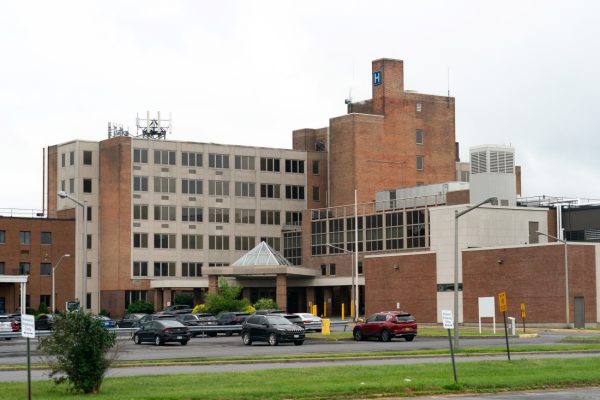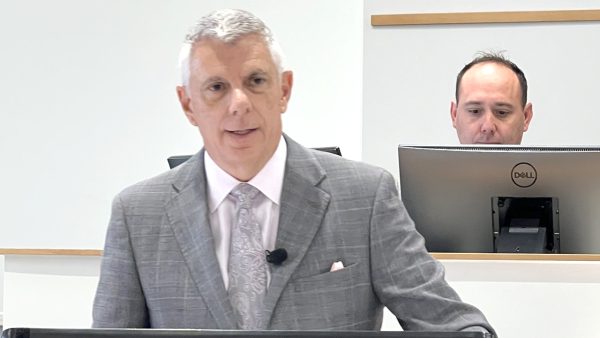Get our email updates
Stay up-to-date on the companies, people and issues that impact businesses in Syracuse, Central New York and beyond.
What's New
Upcoming Events
CNYBJ Job Board

ShoppingTown Mall property to soon have a new developer, McMahon says
DeWITT, N.Y. — The proposed project to redevelop the former ShoppingTown Mall property in DeWitt into District East will have a new developer once the

MVHS imaging department moves to downtown Utica
UTICA, N.Y. — The Mohawk Valley Health System (MVHS) imaging department is opening a new MVHS Imaging Center at the Medical Office Building located at

Former Avis employee at Syracuse airport accused of stealing 47 cars
SYRACUSE, N.Y. — A Syracuse man who used to work at the Avis Budget Car Rental location at Syracuse Hancock International Airport is accused by

Upstate Medical University Arena revamp includes new seating, sound system
SYRACUSE, N.Y. — Upstate Medical University Arena at the Oncenter War Memorial had some changes following a $4 million renovation project that concluded at the end of the 2025-26 Syracuse Crunch ice-hockey season. Onondaga County on Oct. 16 said the improvements include brand new lower-bowl seating; improved accessibility; expanded event spaces; a state-of-the-art sound system;
Get Instant Access to This Article
Become a Central New York Business Journal subscriber and get immediate access to all of our subscriber-only content and much more.
- Critical Central New York business news and analysis updated daily.
- Immediate access to all subscriber-only content on our website.
- Get a year’s worth of the Print Edition of The Central New York Business Journal.
- Special Feature Publications such as the Book of Lists and Revitalize Greater Binghamton, Mohawk Valley, and Syracuse Magazines
Click here to purchase a paywall bypass link for this article.
SYRACUSE, N.Y. — Upstate Medical University Arena at the Oncenter War Memorial had some changes following a $4 million renovation project that concluded at the end of the 2025-26 Syracuse Crunch ice-hockey season.
Onondaga County on Oct. 16 said the improvements include brand new lower-bowl seating; improved accessibility; expanded event spaces; a state-of-the-art sound system; renovated VIP lounge; and a new grab-and-go area, “further elevating the experience for fans, guests, and event organizers alike,” per the announcement.
“From seats and sound to the brand-new Legacy Lounge, these new upgrades at the War Memorial are some of the best yet. Not only will they enhance the visitor experience but also help market the facility to lure new concerts, comedy shows and conventions,” Onondaga County Executive Ryan McMahon said in the announcement. “Onondaga County runs largely on sales tax dollars so anything we can do to bring in visitors and capture their spending helps us lower property taxes for folks right here at home. I encourage everyone to come check out a show or Crunch game and experience all these great upgrades.”
The $4 million renovation project started back in June with an overhaul to the lower-bowl seating, which now offers American-made, permanent seats, produced and installed by Irwin Seating Company, described as “one of the world’s leading manufacturers of audience seating.”
The project also expanded wheelchair-accessible seating for hockey games, and lower-bowl seating in front of the stage was removed, opening up space for a brand new, flexible event area. Additionally, crews installed new retractable seating on the stage, allowing for multiple configurations to accommodate any group using this space during Syracuse Crunch games.
Besides seating, the arena also underwent a major audio upgrade with the installation of a new sound system, featuring Powersoft amplifiers and more than 130 Fulcrum and JBL speakers, designed to “deliver clear, even sound” throughout the venue, Onondaga County contended.
The renovation effort also included the new Legacy Lounge, a space paying homage to the legacy of talent that has played in the arena over the last seven decades with new graphics, flooring, furniture, and gaming. The lounge, which will offer improved food and beverage options, is open to the public during Syracuse Crunch games and will be available as a premium upgrade for non-Crunch events.

St. Lawrence County Chamber recognizes four organizations at annual dinner
CANTON, N.Y. — The St. Lawrence County (STLC) Chamber of Commerce recognized three businesses and one library during its annual meeting held Oct. 22. The STLC Chamber honored Pepsi-Cola Ogdensburg Bottlers as its 2025 Business of the Year. In addition, the chamber recognized Jernabi Coffeehouse of Potsdam for its Customer Service Excellence, Canton Apples &
Get Instant Access to This Article
Become a Central New York Business Journal subscriber and get immediate access to all of our subscriber-only content and much more.
- Critical Central New York business news and analysis updated daily.
- Immediate access to all subscriber-only content on our website.
- Get a year’s worth of the Print Edition of The Central New York Business Journal.
- Special Feature Publications such as the Book of Lists and Revitalize Greater Binghamton, Mohawk Valley, and Syracuse Magazines
Click here to purchase a paywall bypass link for this article.
CANTON, N.Y. — The St. Lawrence County (STLC) Chamber of Commerce recognized three businesses and one library during its annual meeting held Oct. 22.
The STLC Chamber honored Pepsi-Cola Ogdensburg Bottlers as its 2025 Business of the Year. In addition, the chamber recognized Jernabi Coffeehouse of Potsdam for its Customer Service Excellence, Canton Apples & Cider as the Local Producer of the Year, and the Massena Public Library as the Community Cornerstone.
The St. Lawrence County Chamber of Commerce announced the winners of its annual business awards ahead of the annual dinner. The chamber used the event to recognize the recipients for their achievements and contributions to the county’s business climate, quality of life, and character.
“St. Lawrence County and the North Country are filled with remarkable businesses and organizations that are essential to the vitality of our region,” Ben Dixon, executive director of the St. Lawrence County Chamber of Commerce, said in the announcement. “It is wonderful for us to be able to recognize them for the way they support other businesses, enhance our economy, and present our region as an exceptionally great place to be.”

PHOTO CREDIT: ST. LAWRENCE COUNTY CHAMBER OF COMMERCE
About the Business of the Year
Founded in 1943, Pepsi-Cola Ogdensburg Bottlers employs more than 50 local residents and consistently reinvests in modern equipment, facility improvements, and sustainability initiatives that strengthen both its operations and the regional economy, per the STLC Chamber’s announcement.
Under the leadership of the Winter and Wright families, Pepsi-Cola Ogdensburg Bottlers “balances business excellence with exceptional community engagement.” Its philanthropy has supported local initiatives that include the Boys & Girls Club and youth athletics to health care, including support for the Richard E. Winter Cancer Center.
The company also demonstrates ongoing innovation through recent investments in recycling technology and cold-storage systems.

Jernabi Coffeehouse
Jernabi Coffeehouse was recognized with the Customer Service Excellence Award for its “dedication to warmth, consistency, and genuine community connection.” Those nominating the business for the award praised the coffeehouse as an establishment that “embodies hospitality from the moment guests enter,” the STLC Chamber said.
It went on to acknowledge Jernabi’s staff as “friendly, knowledgeable, and professional,” and noted for attention to detail like remembering a regular’s custom order or guiding new customers through the menu.

PHOTO CREDIT: ST. LAWRENCE COUNTY CHAMBER
Canton Apples & Cider
The STLC Chamber presented the award for Local Producer of the Year to Canton Apples & Cider, a business “rooted in tradition, innovation, and community stewardship.”
Canton Apples works to preserve heritage apple varieties, including rare and heirloom strains, “keeping agricultural heritage alive” while offering consumers a distinctive, local product.
The business also demonstrates innovation through its new line of handcrafted ciders. By blending apple varieties, it produces “complex, naturally balanced” flavors.
“Their commitment to quality and the environment is evident in their methods, which include sustainable orchard practices and the use of UV treatment rather than chemical additives,” per the announcement.

PHOTO CREDIT: ST. LAWRENCE COUNTY CHAMBER
Massena Public Library
The St. Lawrence County Chamber of Commerce honored the Massena Public Library with the Community Cornerstone Award for its outstanding contributions through education, inclusion, and connection.
The library serves as a “vibrant hub” that offers free access to technology, lifelong learning, and cultural enrichment for all ages. The chamber praised the library’s staff for its commitment to “making everyone feel welcome.”
The library has also supported the Massena Chamber of Commerce, assisting integration efforts by hosting St. Lawrence County Chamber of Commerce Assistant Director Laura Pearson in a temporary office space.

Eysaman starts as South Side Community Growth Foundation’s first executive director
SYRACUSE, N.Y. — It was back in September when Deka Eysaman made her first public appearance as executive director of the South Side Community Growth Foundation. She attended Home HeadQuarters’ annual Block Blitz, of which the foundation was a community builder sponsor. Since its founding last year, the South Side Community Growth Foundation has started
Get Instant Access to This Article
Become a Central New York Business Journal subscriber and get immediate access to all of our subscriber-only content and much more.
- Critical Central New York business news and analysis updated daily.
- Immediate access to all subscriber-only content on our website.
- Get a year’s worth of the Print Edition of The Central New York Business Journal.
- Special Feature Publications such as the Book of Lists and Revitalize Greater Binghamton, Mohawk Valley, and Syracuse Magazines
Click here to purchase a paywall bypass link for this article.
SYRACUSE, N.Y. — It was back in September when Deka Eysaman made her first public appearance as executive director of the South Side Community Growth Foundation.
She attended Home HeadQuarters’ annual Block Blitz, of which the foundation was a community builder sponsor.
Since its founding last year, the South Side Community Growth Foundation has started cultivating relationships with its McKinley Park neighbors over face-to-face conversations, kitchen table talks, and a private barbeque for the community. Eysaman is charged with “building upon this momentum in order to refine and enhance the organization’s vision,” per the Sept. 29 announcement.
Eysaman has a track record of driving impactful programs and initiatives that spark innovation within public private partnerships and advance equity for marginalized populations, per the announcement.
Eysaman most recently served as assistant director of field organizing at the New York Civil Liberties Union (NYCLU), where she supervised a team of more than two dozen people across the state, directly overseeing the operations of four regional offices.
Under her leadership, NYCLU grew its volunteer network by 30 percent and partnered with statewide organizations to lead a successful campaign to pass an equal rights amendment to the state’s constitution.
The foundation believes the Syracuse community knows Eysaman best from her time serving as former board president of the Urban Jobs Task Force of Syracuse. Eysaman directed the organization’s “I-81 Local Hire” public-advocacy campaign. That effort sought to ensure 15 percent of employees working on the Interstate 81 viaduct-replacement project would be hired from the local community, bringing more than $7 million into the economy through their earned wages.
In that role, Eysaman raised more than $600,000 in funding from government and foundation sources; helped shape local policies; supported the creation of the Syracuse Build initiative; and helped the Urban Jobs Task Force through its transition from a 501 (c)(4) to 501 (c)(3) nonprofit organization.
She also oversaw the task force’s process to hire its first executive director.
Eysaman brings experience in programming and youth development, previously serving as teen program director for the Boys & Girls Clubs of Syracuse and program associate for the Syracuse University Science and Technology Entry Program (STEP). She was a 40 Under Forty recipient, recognized in 2020 by BizEventz and The Central New York Business Journal.
“I am honored to join the South Side Community Growth Foundation as its first executive director. This is an extraordinary opportunity to serve a community that is far too often forgotten, and to work alongside neighbors, partners, and leaders who are deeply committed to advancing equity and opportunity on the South Side,” Eysaman said in the announcement. “I look forward to bringing my experience in advocacy, community programming and facilitating cross-sector collaboration to help ensure that every resident has access to the resources they need to thrive.”
The nonprofit South Side Community Growth Foundation works to support South Side neighbors by partnering with neighbors, businesses, and government to invest in community initiatives. Established by local philanthropist Chedy Hampson (who founded and later sold TCGplayer.com for $295 million), the foundation’s focus areas include affordable housing and activities that support economic mobility of South Side residents.
“We are thrilled to have Deka at the helm,” Hampson said. “Her proven record of leading impactful initiatives, combined with her deep connection to the Syracuse community, makes her the ideal leader to guide our mission forward in ways that truly serve our neighbors.”

Oneida County lawmakers to vote on proposed $560 million budget
UTICA, N.Y. — The Oneida County Board of Legislators on Nov. 12 will vote on the 2026 budget proposal that was recently introduced with the

Le Moyne to use $5M grant for grad students seeking health degrees
SYRACUSE, N.Y. — Le Moyne College will use a five-year, $5 million state grant to support graduate students enrolled in certain health-care programs. The money comes from the new statewide Healthcare Education and Life-skills Program (HELP). The HELP initiative assists students pursuing careers in health care by offering wrap-around services and support to address the
Get Instant Access to This Article
Become a Central New York Business Journal subscriber and get immediate access to all of our subscriber-only content and much more.
- Critical Central New York business news and analysis updated daily.
- Immediate access to all subscriber-only content on our website.
- Get a year’s worth of the Print Edition of The Central New York Business Journal.
- Special Feature Publications such as the Book of Lists and Revitalize Greater Binghamton, Mohawk Valley, and Syracuse Magazines
Click here to purchase a paywall bypass link for this article.
SYRACUSE, N.Y. — Le Moyne College will use a five-year, $5 million state grant to support graduate students enrolled in certain health-care programs.
The money comes from the new statewide Healthcare Education and Life-skills Program (HELP). The HELP initiative assists students pursuing careers in health care by offering wrap-around services and support to address the workforce shortages across the health-care sector, Le Moyne said.
The grant will support graduate students in the Purcell School for Professional Studies enrolled in nursing, physician-assistant studies, clinical mental-health counseling, and occupational therapy.
The $5 million grant from the New York State Department of Health will start on Jan. 1, 2026. It represents the second largest in Le Moyne’s history behind the $7.2 million received in 2022 to fund the ERIE21 program.
“My deepest gratitude to the many faculty, program directors and staff who contributed to the data collection and writing of the grant proposal to develop the innovative concept that resulted in this funding,” Le Moyne President Linda LeMura said in an announcement. “It was truly a collaborative effort across the College.”
This HELP initiative is part of a broader $10 billion in funding announced by Gov. Kathy Hochul in 2022 with a goal of rebuilding and expanding the health-care workforce. The program’s goal is to address health workforce shortages by providing support services to health-care trainees, thereby enhancing the career pipeline and improving access to health care training in underserved areas.
HELP offers annual funding availability of $19.5 million, Le Moyne said.
The program HOPES
This student funding and support program will be called Healthcare Opportunities for Professional and Educational Success (HOPES). In addition to financial support for more than 50 students each year, the program will involve three programming pillars: transition into the program, transition to the profession, and transition to practice.
Le Moyne College’s Office of Graduate Admission and Success and the Purcell School will oversee the program’s implementation, the school noted.
The tiered approach will provide support to onboard, retain, and qualify graduate students in the health-care field. It ties directly to Le Moyne’s strategic plan, called “Tomorrow Together.” The plan calls for the institution to “assess local and regional markets for partnerships that increase programmatic reach” and also aligns with its Jesuit tenant of “cura personalis,” or care of the whole person.
“The grant will increase resources critical to running programming, coaching students and providing vital services to support student success,” Meega Wells, dean of the Purcell School for Professional Studies, said. “It will benefit our graduate healthcare students in many ways throughout their journey through their respective programs.”

Renovation project at Rome Family YMCA is ongoing
ROME, N.Y. — The first phase of the renovation effort at the Rome Family YMCA on West Bloomfield Street is ongoing after transitioning from plans for new construction to an “ambitious” remodeling effort. The work conducted so far has included a brand-new Spin Studio with modern lighting, sound, and air conditioning, along with new paint,
Get Instant Access to This Article
Become a Central New York Business Journal subscriber and get immediate access to all of our subscriber-only content and much more.
- Critical Central New York business news and analysis updated daily.
- Immediate access to all subscriber-only content on our website.
- Get a year’s worth of the Print Edition of The Central New York Business Journal.
- Special Feature Publications such as the Book of Lists and Revitalize Greater Binghamton, Mohawk Valley, and Syracuse Magazines
Click here to purchase a paywall bypass link for this article.
ROME, N.Y. — The first phase of the renovation effort at the Rome Family YMCA on West Bloomfield Street is ongoing after transitioning from plans for new construction to an “ambitious” remodeling effort.
The work conducted so far has included a brand-new Spin Studio with modern lighting, sound, and air conditioning, along with new paint, padding, and backboards in the gymnasium, per the Sept. 23 announcement.
Crews have also installed an electric gymnasium divider curtain.
In addition, the work has included pool maintenance and safety upgrades completed during the summer, refinished gymnasium hardwood floors; delivery and installation of $175,000 in cardio equipment; and the renovation of the cardio room with modern lighting, electrical, flooring, and aesthetics.
The work that is still to come will include repurposing underutilized spaces, including new personal training and group exercise areas. Second phase projects will also involve locker rooms, spa, roof, and energy-efficient systems with support from National Grid and NYSERDA. The second-phase work will target the venue’s heating, ventilation, and air conditioning system.
“This renovation allows us to expand our offerings and improve the facilities that have served our community for many generations,” Hank Leo, CEO, said in the announcement. The revitalized YMCA will feature modern fitness spaces, family-friendly areas, and enhanced programs for childcare and youth engagement. As the renovation progresses, the YMCA looks forward to inviting the community to experience the updates firsthand and join in the effort.”
The Rome Family YMCA was established in 1871. It is one of the oldest nonprofit organizations in the region and was founded only 27 years after the first YMCA in London. Rome Family YMCA is part of the YMCA of the Greater Tri-Valley, which also includes the Oneida Family YMCA and YMCA Child Care in Whitesboro.

NIH grant helps Cornell start autism-research center
ITHACA, N.Y. — Cornell University’s Ithaca campus and Weill Cornell Medicine in New York City are starting an autism-research center using a three-year, $5.1 million
Get our email updates
Stay up-to-date on the companies, people and issues that impact businesses in Syracuse, Central New York and beyond.
